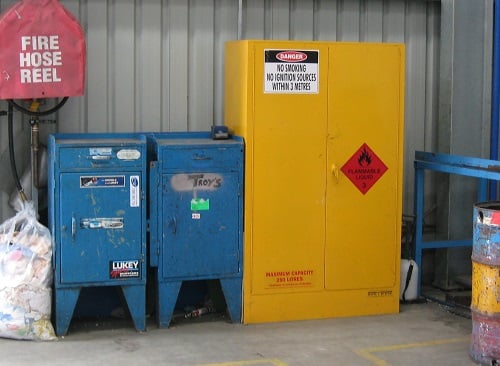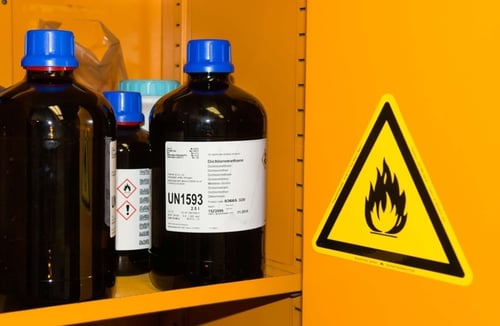When you’re working with dangerous goods or hazardous chemicals, it’s vital for the safety of your staff, organisation and surrounding community, that you reduce risk with your handling and storage areas. One of the key pieces of storage equipment to reduce risk is a chemical cabinet. But how does a cabinet protect your business from incidents such as fire, explosion, spillage and harmful vapour emissions? In this post, we explore the features of a chemical cabinet and how they can effectively reduce risk in your storage areas.
Risk Control Features
There are a multitude of risk control features found in a compliant chemical cabinet. However, each class of cabinet will offer different features that specifically relate to the dangerous goods class of the chemical product that it’s housing.
When we talk about general risk controls that are apparent in the design and construction of chemical storage cabinets, we’re generally focused on controlling 2 things:
- Chemical spillage – controlled through the design and construction of a liquid-tight spill containment sump built into the lower compound of the cabinet
- Hazardous vapours – contained within the cabinet due to the close-fitting, tight closing doors and sheet steel construction

The 2 key chemical hazards that your cabinet will control are the risk of spillage and the containment of hazardous vapours.
However, there are other features that are required to safely store chemicals in the indoor environment.
Other required features may include:
- Security – a lockable cabinet helps to prevent unathorised entry, vandalism, theft and general misuse of the chemicals
- Thermal protection – to keep stored chemical packages in an environment that is protected from extreme heat or fire
- Option for ventilation – some stores may require a mechanical ventilation system to be installed if the vapour levels exceed the legal limits
- Impact protection – packages require safe storage in a cabinet that offers protection against impact damage
Understanding Chemical Storage Cabinet Standards
When housing hazardous chemicals in the work environment, there are many options available for indoor chemical storage.
However, to achieve a compliant workplace, that meets the obligations of WHS Legislation and Regulations, you’ll need to select chemical storage that is deemed compliant.

A compliant chemical storage cabinet is the first step in achieving compliance in your storage areas.
But what makes a chemical cabinet compliant or non-compliant?
In Australia, WHS Legislation outlines the compliance obligations for all workplaces that carry hazardous chemicals or dangerous goods. However, within these Regulations, there is little detailed information about how to actually create a compliant environment. That’s where the Australian Standards come in.
While the Australian Standards aren’t technically law, they do provide highly detailed guidance on how to safely handle and store all different types of dangerous goods. There is a corresponding Australian Standard for each class of chemical that you may be carrying. Therefore, to determine the chemical storage cabinet standards, you must refer to the applicable standard for the product that you’re looking to store.
REMEMBER: If you purchase a piece of storage equipment that doesn’t meet the requirements of the Australian Standards, you could be at risk of chemical hazards — and putting your business in breach of compliance regulations. Hazardous chemicals and dangerous goods require specific risk control features if they are to be stored safely and in compliance.
Risk Controls Featured In Compliant Cabinets
So, what are the features of a compliant chemical storage cabinet — and how do they offer risk control for organisations that carry hazardous chemicals?
As we mentioned earlier in this blog, there are a multitude of features designed and constructed into a compliant cabinet. These features are required to reduce both the likelihood – and the impact – of incidents, such as spillage and vapour emissions.
Let’s now look at these features and how they can reduce chemical risk in your business.
Spillage
Hazardous chemical spillage can occur in any workplace. Simple mistakes, such as a drum being knocked over, can result in an accidental release of chemicals into the workplace. Spillage can spark a range of dangerous incidents in a workplace, from fires and explosions (if the vapour trail meets an ignition source) to the pollution of the surrounding environment (when chemicals leak into drains, soil or waterways).
Clearly, the control of the accidental release of harmful chemicals is an important factor in risk management.
Compliant chemical storage cabinets are a bunded storage solution that minimises the likelihood of chemicals spilling out into the workplace where the cabinet is kept.
The cabinet provides risk control for spillage through various features including:
- Liquid-tight spill containment sump
- A compliant sump capacity to adequately contain the spill
- All spills and leaks that occur within the cabinet are directed into the sump
- A simple-to-use sump that enables spillage to be quickly cleaned out
- Self-closing, tight-fitting doors that prevent chemicals splashing out into the work area when the cabinet doors are closed
Harmful Vapours
Hazardous vapours pose many threats both to people and property. Some chemicals such as kerosene, dimethyl sulfide and benzene emit vapours that can be easily noted due to their strong smell, however others may not carry an odour. Therefore, harmful vapours can travel quickly (and often undetected) throughout organisations — harming human health and posing an ignition and flashback risk.
REMEMBER: It’s not actually the liquid chemical that is flammable. The vapours emitted from leaking or spilled chemicals can ignite in the presence of a ignition source, such as a power point, welding equipment or hot surface.
While maintaining careful chemical handling procedures and strict housekeeping protocols is essential for the management of vapours, a chemical cabinet provides a storage space that contains these emissions.
Compliant cabinets are equipped with perforated shelving, which allows the vapours to circulate freely within the cabinet when the doors are shut. The self-closing, tight fitting doors of a compliant cabinet prevent the vapours escaping into the workplace when the cabinet’s not in use.
If you are concerned that vapour emissions from your chemicals aren’t at a safe level, you must monitor the quality of your air to ensure that vapour concentrations don’t exceed the legal limits. These details are found in Safe Work Australia’s workplace exposure standards for airborne contaminants.
Hazard Awareness
If your staff aren’t aware of the hazards associated with your indoor store of chemicals, then how can they make sure that they’re following the correct handling and storage procedures?
One of the most obvious features of a compliant chemical cabinet is the dangerous goods and hazard signage displayed on the front of the cabinet. It’s not only your legal obligation to install the correct dangerous goods signage on your cabinet — you’re also obligated to ensure that the signage remains intact and visible.
Each class of dangerous goods requires its own particular DG diamond and hazard identification. For example, Class 3 Flammable Liquids require the applicable dangerous goods diamond (250mm x 250mm), as well as a warning sign that prohibits ignition sources within 3 metres of the cabinet.
This signage alerts staff to the goods stored within the cabinet, as well as offering them instant knowledge about the hazards associated with the chemicals. A compliant cabinet will already be equipped with the relevant signage, however, it’s your responsibility to make sure that the signage is replaced if it goes missing or deteriorates.
Security
If chemicals are handled incorrectly, they can cause severe harm to human health, as well as destruction of property and the contamination of the natural environment. Therefore, when storing your chemicals in the workplace, it’s important that you consider how you can secure your products and prevent unauthorised people accessing the cabinet.
Indoor chemical cabinets are equipped with lockable doors that may be secured when the cabinet is not in use. This prevents a range of problems from occurring such as:
- Untrained staff using chemicals incorrectly
- Staff overusing chemical products
- Theft of the supplies
- Damage of chemical packages
- Acts of vandalism using stored chemicals onsite
Only fully trained staff should ever be allowed to use a chemical cabinet and handle its contents. Without adequate training staff can put themselves — and their workplace — at serious risk.
Lockable cabinets also help maintain chemical inventories and reduce wastage. Having a secure, dedicated cabinet may also encourage staff to act responsibly when handling chemical supplies.
Thermal Protection
Have you ever seen a news report on a factory explosion caused by the ignition of hazardous chemicals? As you will know from these reports, fire and explosion can happen at any workplace that carries hazardous substances, from breweries to factories and restaurants.
While there are many ways in which a fire or explosion can occur in your chemical stores (such as spilled chemicals flowing into an area where there is an ignition source), it’s important to prevent further damage from occurring if a blaze breaks out in your work area.
Compliant chemical storage cabinets feature a thermic air barrier within a sheet steel construction. Along with the tight-closing doors, the construction of the cabinet provides a level of protection for the stored chemicals. While not preventing the chemicals from reacting the fire, the construction does allow a small window of time where the packages will be protected, so staff can action emergency plans or use fire extinguishing equipment.
Many hazardous chemicals will only add to the harmful and toxic vapours created by the fire, as well as increasing the ferocity of the blaze. Protection from heat and fire is essential if you want to reduce chemical risk in your indoor stores.
Are Chemical Cabinets Part Of Your Risk Management Plan?
If you’re interested in learning more about ensuring a safer and more compliant workplace, grab a copy of our helpful eBook. Essential Considerations When Storing Flammable Liquids Indoors offers advice on how to understand and assess your compliance obligations, so you can successfully select, install and maintain a compliant chemical cabinet.
Joining the team as a Dangerous Goods Storage Consultant, Melissa Hampton became Storemasta's Marketing Manager in late 2021. With extensive knowledge and experience in chemical compliance, Melissa is responsible for leading the Marketing team and helping shape their marketing strategy. In her spare time, you can find Melissa hiking, swimming and enjoying the great outdoors in beautiful north-west Tasmania.

